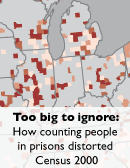
Too big to ignore:
How counting people in prisons distorted Census 2000
By Rose Heyer and Peter Wagner
Prison Policy Initiative
April 2004
Section:
Executive Summary
By Rose Heyer and Peter Wagner
Prison Policy Initiative
April 2004
The Census Bureau counts people incarcerated in state and federal correctional facilities as if they were residents of the prison town. Although incarcerated people are not a part of the prison town, they are a part of the community’s statistics.
When the Census began, demographics-based planning and redistricting did not yet exist. Until recently, the numbers of incarcerated people were low. The 1990 Census was the first Census to see a sizable increase in the percentage of Americans in prison. A movement is now underway to have the Census change how it counts people in prison. Until the Census changes its methodology, many data users have to adjust their data. Why?
Although few communities are “average”, incarcerated people are far from the average demographic. Ninety-two percent of people incarcerated in federal and state prisons are men. Blacks and Latinos are only a quarter of the U.S., but they are almost 63% of the nation’s incarcerated.
Prisons tend to distributed differently than the general population in a state. In New York, 25% of the state lives in the upstate rural and upstate urban areas. Ninety-one percent of the state’s prisoners are incarcerated there, mostly in the upstate rural areas.
Research in to the geographic disparities of incarceration is ongoing, but a clear pattern is emerging:
- Sixty percent of Illinois’ prisoners call Cook County (Chicago) home, yet 99% of the state’s prison cells are outside the county.
- Los Angeles County supplies 34% of California’s prisoners, yet only 3% of the state’s prisoners are incarcerated there.
- Philadelphia is the legal residence for 40% of Pennsylvania’s prisoners, but the County contains no state prisons.
- Wayne County (Detroit) is home for 20% of Michigan’s population. Almost 30% of the state’s prisoners are from Wayne County, but only 11% of the state’s cells are there.
Counting large external populations of prisoners as local residents leads to misleading conclusions about the size and growth of communities. Twenty one counties in the United States have at least 21% of their population in prison. Counties that see prisons close report that their populations declined when in fact they did not, or declined only slightly. Conversely, population growth reported by some counties is due to the importation of prisoners to a new correctional institution. If not for the construction of new prison cells, 56 counties labeled as growing would have reported declining populations.
Because of the large racial disparity in incarceration, there can also be a subtle change in how the racial, ethnic and gender distributions within a state are portrayed in the Census. For example, the Census shows that predominantly White Franklin County in New York has a rapidly growing Black population. That would be news to the residents of the county, who don’t consider the prisoners to be residents. Ninety-one percent of Franklin County’s Black population is incarcerated in the county’s five state prisons.
The statistical impact is largest in prison hosting communities because the incarcerated population tends to be a large portion of the community. It is often possible for a knowledgeable researcher — at great effort — to adjust the data to remove the incarcerated population. Although the magnitude of the impact is smaller in the prisoner-exporting communities, Census data is of no assistance in restoring incarcerated people back to their census block of origin. Researchers and policymakers must instead rely on judicial or corrections data which rarely contain the same level of detail as official Census data.
Thankfully, Census Bureau policy on how to count the population is not fixed, instead it responds to changing needs. When evolving demographics meant more college students studying far from home and more Americans living overseas, the Census policy changed in order to more accurately reflect how many Americans were living where. Today, the growth in the prisoner population requires the Census to update its methodology again. Until then, data users have a special challenge.
Events
- April 15-17, 2025:
Sarah Staudt, our Director of Policy and Advocacy, will be attending the MacArthur Safety and Justice Challenge Network Meeting from April 15-17 in Chicago. Drop her a line if you’d like to meet up!
Not near you?
Invite us to your city, college or organization.



